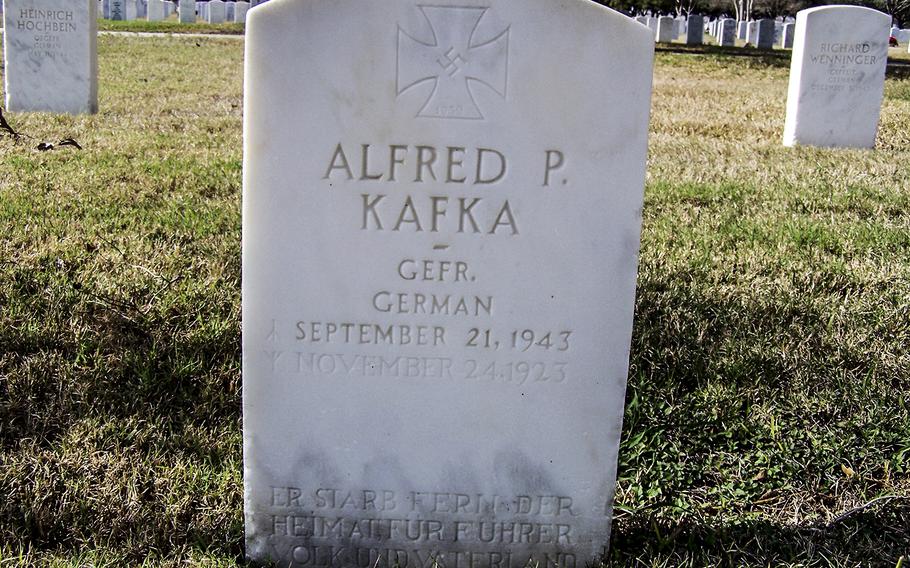PORTLAND, Maine (Tribune News Service) — On Oct. 14, 1944, an escaped German prisoner of war strolled into a shop in New York City's Union Square. He was there to buy canvases.
The Austrian-born painter had walked off a logging work detail in the New Hampshire woods two months earlier, leaving a note saying the labor was destroying his hands and he was afraid he would lose his ability to paint. Art was all that mattered to him.
An alert art supply store clerk who had been shown the man's picture in advance called the FBI. Franz Bacher, 28, was arrested without incident. Instead of facing harsh punishment, Bacher was sent to a Maine prisoner-of-war camp where — in addition to picking potatoes for local farmers — he was allowed to paint.
Camp Houlton in Aroostook County had a dedicated art program. Many of the 3,500 men held there between 1944 and 1946 took advantage. Nearly 80 years later, their creative works are reaching a wider audience thanks to a joint online and in-person exhibition between museums in Houlton and Portland. Two of Bacher's paintings are included.
Though all of the art is historically significant and chronically understudied, it represents a wide range of skill levels.
"Some of it is absolutely gorgeous and some of it looks like it was painted by your uncle," said Tilly Laskey, co-curator of the exhibition.
Laskey, of the Portland-based Maine Historical Society, created the show with Henry Gartley at the Aroostook County Historical and Art Museum of Houlton, where the paintings reside. The two institutions are connected by the Maine Memory Network.
The network, administered by the historical society, is a searchable database of significant photos, documents and artifacts held in more than 270 collections across Maine. The Aroostook museum is one of the biggest, most active contributors, with over 700 items listed.
The online portion of the new exhibition, "Passing the Time: Artwork by World War II German POWs," is now live. An in-person version goes up at the historical society in Portland next month. It will include life-sized reproductions of the prisoners' artworks, which are on permanent display in Houlton. It will also feature many historical photographs.
"The goal of partner exhibitions, like this one, is to let people know about collections all around the state," Laskey said. "We want them to go and see them in person, to make the trip up to Aroostook County."
Houlton Army Air Base opened in 1942 and German prisoners began arriving in 1944 to help with logging and farming amid a massive labor shortage with soldiers overseas.
Prisoners were paid a dollar daily in credit that they could spend at the post exchange store on things like chocolate, tobacco and art supplies. In addition to the space and materials to paint, the German prisoners were offered education classes through the University of Maine.
Despite being enemies of the United States during a time of war when many local men were fighting overseas, most of the Germans were well-regarded by locals as hard-working and friendly.
"A lot of them were reluctant soldiers," Laskey said. "Some were political prisoners just thrown out there as cannon fodder. Of course, some were also dedicated Nazis, as well."
Many were also young and frightened. One soldier, just 15, broke out in tears when asked to dig a latrine pit. When asked why, he said he had believed he was digging his own grave.
Another prisoner, Vohn Micka, returned to Germany after the war, finding it devastated and poverty-stricken. With an infant and wife to support, he wrote to the farmers he had worked for in Aroostook County. They sent supplies, food and baby formula.
The surviving works of art in the Aroostook collection were either given as gifts or bought by locals. Most, though not all, of the subject matter is German and nostalgic in nature.
One painting depicts a vase of flowers in vibrant colors. The artist is unknown but prisoners Walton Haase, Gunther Magdeburg and Gerhard Nowitsky, gave it to their guard, John D. Willard, as a wedding gift on August 31, 1945. Another simple painting of a birch tree and pond is simply signed P. Yearicks.
Bacher's paintings include a seaside landscape, of possibly Greece or Italy, with stone buildings and tattered sails hung to dry. Bacher was a leftist who spoke four languages. After running afoul of the Nazi regime, he was sent to the front lines in North Africa. He was captured at Bizerte, Tunisia. After the war, Bacher had a successful art career and died in Austria in 1981.
Perhaps the most astonishing picture on display is a portrait of Mary Ellen and Herman Porter's daughter, Lois, who was 8. Painted by an unknown prisoner, the smiling picture indicates a high level of intimate trust not normally associated with wartime.
In 2003, several former prisoners returned to Houlton when invited by the town. They were then named honorary citizens in a ceremony. One said then that the experience "changed my life and the outlook of my life and how to see people and judge people."
As for the art created at Camp Houlton, Gartley suspects it provided a kind of therapy for the traumatized soldiers far from home.
"I do a little watercolor painting myself," he said, "and when you focus on painting, everything else just kind of goes away."
"Passing the Time: Artwork by World War II German POWs" is online now. The original paintings are on display at the Houlton Historical and Art Museum. The Maine Historical Society exhibition opens Aug. 11 in Portland.
(c)2021 the Bangor Daily News (Bangor, Maine)
Visit the Bangor Daily News (Bangor, Maine) at www.bangordailynews.com
Distributed by Tribune Content Agency, LLC.

Headstone of a fallen German WWII POW. (Michael Field)